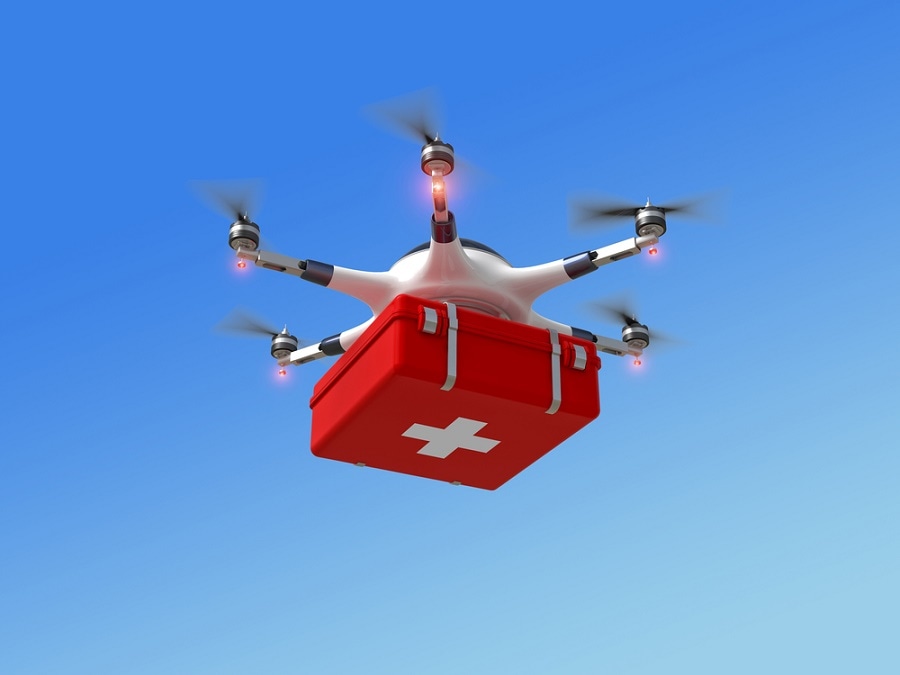Jun 23 2016
A recent study has suggested the use of drones to deliver vaccinations in countries with less income. The research was headed by the Johns Hopkins Bloomberg School of Public Health and the Pittsburgh Supercomputing Center. The usage of drones can have the dual benefit of saving money and improving the vaccination rates in these countries.
 Image Credit: gualtiero boffi | Shutterstock.com
Image Credit: gualtiero boffi | Shutterstock.com
The research was recently presented in the journal Vaccine on June 20. It states that using drones would not only reduce the time taken but also help avoid fuel and maintenance charges that will have to be incurred if the vaccination was delivered by land.
Many low- and middle-income countries are struggling to get lifesaving vaccines to people to keep them from getting sick or dying from preventable diseases. You make all these vaccines but they’re of no value if we don’t get them to the people who need them. So there is an urgent need to find new, cost-effective ways to do this.
Bruce Y. Lee, MD, MBA, Associate Professor, Bloomberg School
Immunization programs in low- and middle-income countries face a lot of difficulties. These programs are responsible for delivering childhood vaccinations for rotavirus, measles, hepatitis B and tetanus. They will also have to provide vaccines for malaria, Zika and dengue when the vaccines reach the market. Before reaching clinics where the vaccines are administered they are delivered via road. These vaccines are mostly stored in two to four different places on the way. In the interim period between entering a country and reaching their destination these vaccines will have to be refrigerated to avoid wastage. Over one-third of non-vaccine costs are spent on supply chain logistics and the overall non-vaccine costs are expected to increase by 80% between 2010 and 2020. Problems in the supply chains may lead to vaccines not being delivered where there are needed.
In the last few years the usage of unmanned drones has replaced vehicles due to their ability to cross difficult terrains and the resultant reduction in labor costs. Though, initially it was not clear if the usage of drones would be cost-efficient, they are used for various purposes today. Currently drones are used for providing humanitarian air and for surveillance. New drones are also being designed to deliver medicinal supplies.
The research team designed a HERMES computer model to stimulate a transportation system, which is a combination of land-based vehicles like motorbikes, public transits and trucks. They then compared the system with a drone for delivering vaccinations. The data for the drone system was offered by a Seattle-based NGO called Village Reach. The team changed characteristics like population, vaccine schedule, road conditions and geography so as to figure out the ideal conditions that can offer more scope for cost saving.
After this exercise, the team was able to come to the conclusion that using drones to deliver vaccines to their final destination improved the availability of vaccines. The drone delivery can immunize 96%, as opposed to the 94% achieved by land-based transport, of the target population. The drone usage can also lead to approximately 20% cost saving, by reducing the cost of each vaccine dose administered by 8 cents.
The minimum delivery quantity required to save money is .4 liters for each drone. The team has conformed that the drones are capable of delivering 1.5 liters each. If the drones fly at the scheduled time without any delays and carry the estimated 1.5 liters, then the cost per flight is estimated to be $8.93. Even with the overhead and annual infrastructure estimated at $60,000 the drones promise significant cost saving. The research team also analyzed the land-based immunization system in Mozambique. Though Mozambique has accomplished immunization coverage of 94%, the team has found that many other countries are able to reach less than 60% of the population through land transportation systems.
Currently, in many locations, vehicles that transport vaccines aren’t always available or reliable. Assuming that drones are reliable, are capable of making the necessary trips and have properly trained operators, they could be a less expensive means of transporting vaccines, especially in remote areas. They could be particularly valuable when there is more demand for certain vaccines than anticipated and immunization locations must place urgent orders.
Bruce Y. Lee, MD, MBA, Associate Professor, Bloomberg School
Though the team has been able to show that cost saving is possible through theoretical analysis done using computer models, the researchers state that the drones will have to be tested in the real world, where many hindrances may arise, to ensure that they can be a viable means of delivering vaccinations. Regulatory issue is one such hindrance that can prove problematic to the ability of unmanned drones in delivering goods. Another potential problem would be the availability of special skills and tools that are required for the maintenance and operation of the drones. As these drones are unmanned the delivery operations would also require greater coordination between the shipping and the receiving parties. In addition, appropriate packing that will ensure quality of vaccines would remain unaffected, will also have to be developed.
Tests are being conducted in Bhutan, Papua New Guinea and Virginia to ascertain the viability of drones in transporting medical supplies. In Malawi, drones are tested for their ability to deliver lab samples, by UNICEF. Efforts are being taken in Tanzania to deliver essential medications and blood using drones.
“The Economic and Operational Value of Using Drones to Transport Vaccines” was written by Leila A. Haidari, MPH; Shawn T. Brown, PhD; Marie Ferguson, MSPH; Emily Bancroft, MPH; Marie Spiker, MSPH; Allen Wilcox, JD; Ramya Ambikapathi, MHS; Vidya Sampath, MSPH; Diana L. Connor, MPH and Bruce Y. Lee, MD, MBA.
The research was supported by the Eunice Kennedy Shriver National Institute of Child Health and Human Development (UO1HD086861 and U54HD070725), the Agency for Healthcare Research and Quality (RO1HS023317) and the Bill and Melinda Gates Foundation.